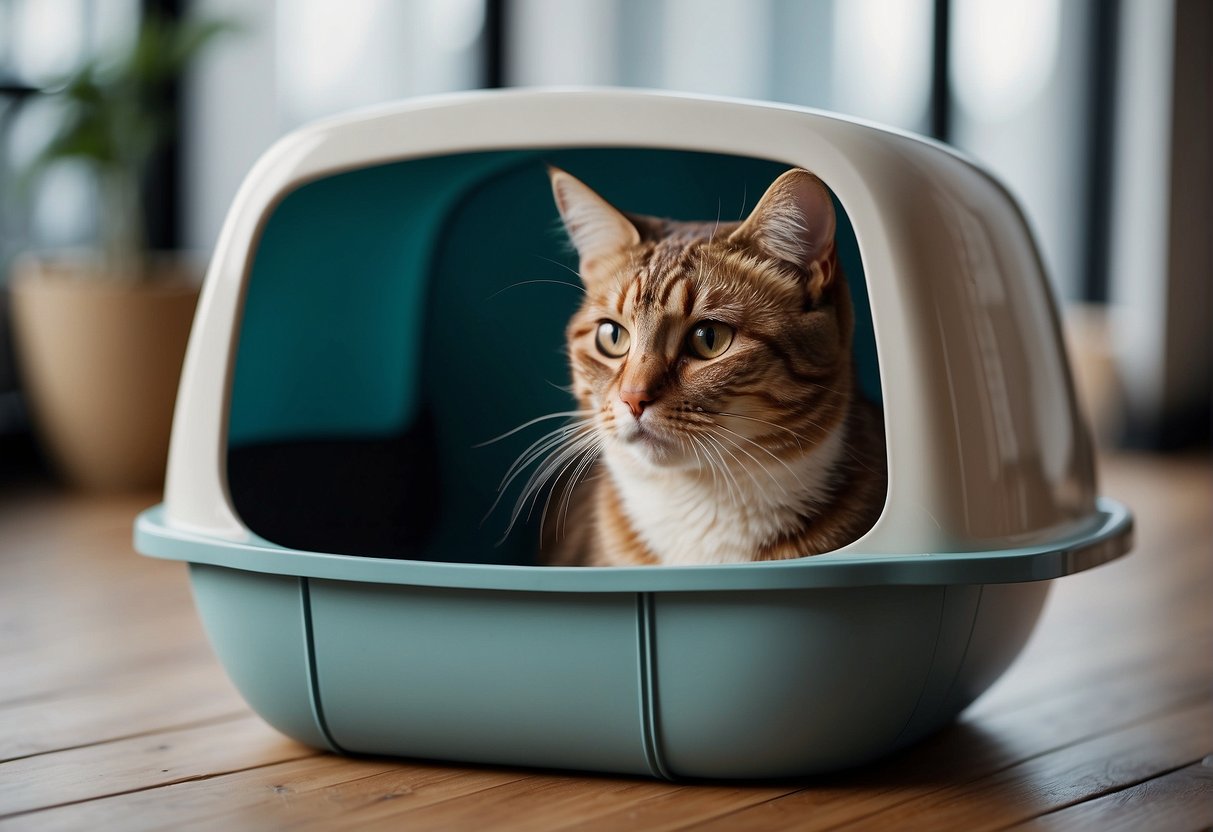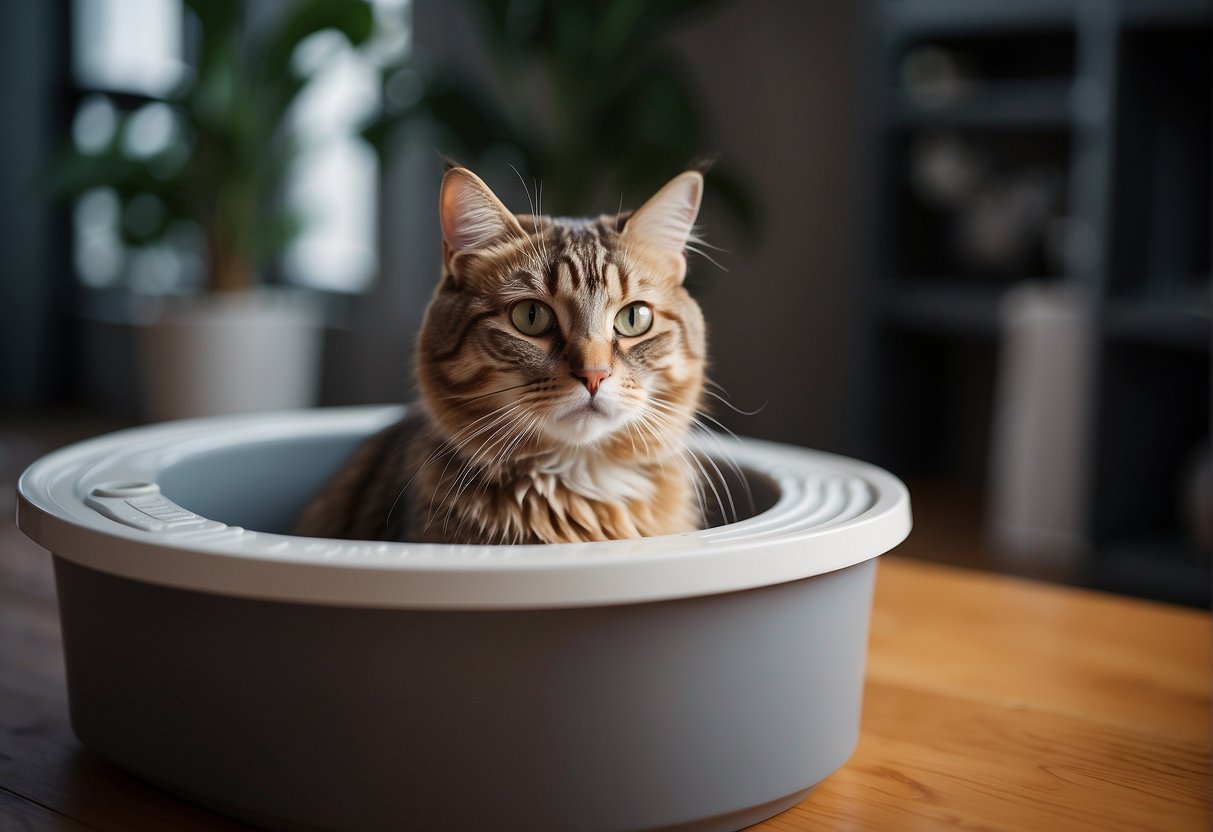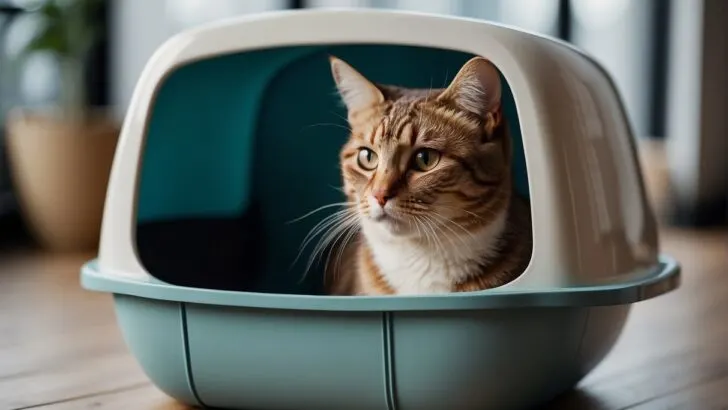Choosing the right size for a litter box is crucial for your cat’s comfort and hygiene. A litter box should be at least one and a half times the length of your cat to ensure they have enough space to move around and do their business without feeling cramped.
For instance, if you have a larger breed like a Maine Coon, which can stretch up to 32 inches in length, a sufficiently sized litter box would be at least 48 inches long to accommodate them comfortably. This is especially important as cats prefer a clean and spacious area to relieve themselves and may avoid a litter box that feels too small.

When picking a litter box, it’s also vital to consider the number of cats you have. The “n+1 rule” suggests having one more litter box than the number of cats in your household to prevent competition and hygiene issues. So, if you’re a proud owner of two cats, aiming for three litter boxes would help maintain peace and cleanliness.
The size and number of litter boxes play a significant role in your cat’s well-being. A cramped or overcrowded litter box can lead to undesired behaviors or health concerns, thus making the choice of litter box size an essential aspect of caring for your feline friend.
Determining the Right Litter Box Size

Choosing the correct litter box size is crucial for your cat’s comfort and cleanliness. Your furry friend needs ample space to do their business without any difficulty.
General Size Recommendations
When selecting a litter box, the dimensions are vital. A good rule of thumb is to ensure the length of the litter box is at least as long as your cat from nose to tail tip when extended, and the width should be equal to the length of your cat without the tail. It’s recommended to look for a litter box that is:
- Length: At least as long as your cat (nose to tail tip)
- Width: At least as wide as your cat (tail not included)
- Height: Tall enough so litter doesn’t spill out, typically 5-8 inches
- Depth: Enough to hold 2-4 inches of litter for digging and covering
For a covered litter box, ensure it’s at least 5 inches taller than your cat in a sitting position, providing headroom above while crouched.
Adjusting for Multiple Cats
Having multiple cats means more consideration is necessary. The standard is one litter box per cat plus one extra, to prevent disputes and keep peace in multicat households.
If space is limited, you can opt for larger boxes that can accommodate more than one cat, but always ensure private space for each. A larger box in multicat homes should have:
- Increased dimensions: To allow for multiple cats to use comfortably
- A suitable number of boxes, larger sizes can be a temporary solution but individual boxes are preferred
Types of Litter Boxes and Features
When choosing a litter box for your feline friend, consider the variety of types available and their unique features. From covered to self-cleaning options, each cat litter box has its own set of advantages and challenges that can cater to different needs.
Pros and Cons of Covered Litter Boxes
Covered Litter Boxes offer privacy for your cats and help contain odors and litter tracking. However, some cats may find enclosed spaces unpleasant, and these boxes can be a bit more cumbersome when it comes to cleaning.
- Pros:
- Reduces litter scatter
- Contains odors
- Provides privacy for cats
- Cons:
- Can be less inviting for some cats
- Requires more effort to clean
- May not accommodate larger breeds comfortably
Importance of Accessibility for Senior and Mobility-Impaired Cats
If you have a senior cat or one with mobility issues, an open litter box with low sides is ideal. It’s crucial for these cats to have easy access to their litter box, so avoid anything too high or with a narrow entrance.
- Features for accessibility:
- Low entry point
- Spacious interior
Innovations in Self-Cleaning and Disposable Options
The latest self-cleaning boxes take convenience to the next level with automatic waste removal, perfect for busy cat owners. Disposable litter boxes, on the other hand, offer a one-time use alternative that’s convenient and hygienic, although they do contribute more waste to the environment.
- Self-Cleaning Boxes:
- Automated cleaning
- Reduces hands-on maintenance
- Disposable Boxes:
- One-time use, no cleaning required
- Ideal for travel or temporary setups
Placement and Maintenance for Optimal Use
When setting up your cat’s litter box, prioritizing the right location and maintaining a diligent cleaning routine are crucial for your cat’s comfort and health, as well as for keeping your home odor-free.
Selecting the Ideal Location
Finding a spot for the litter box that balances convenience with your cat’s need for privacy will set the stage for successful litter box use. Choose a low-traffic area of your home that still offers easy access. This could be a corner of a laundry room or a spare bathroom.
Ensure that the location is away from noisy appliances and too much household activity. Adequate ventilation is important to keep odors at bay, but avoid placing the litter box directly under vents that can startle your cat.
Make sure the area has enough space for your cat to enter and exit comfortably, and consider placing the litter box with enough clearance from the walls to avoid urine being sprayed onto them.
Odor Control and Cleaning Routines
Consistent cleaning is the key to odor control and encouraging your cat to use the litter box. A rigorous scoopingschedule, ideally once or twice a day, removes waste and prevents smells from becoming overpowering.
For clumping litter, it’s necessary to scoop out the clumps to keep the rest of the litter fresh. Plan for a deep cleaning of the litter box itself with a mild detergent on a weekly basis, or more often as needed. This includes replacing the litter entirely or according to the type of litter used.
Utilizing litter designed to control odors can be hugely beneficial, but never use strong chemicals or perfumes that can deter your cat. Remember, your diligent maintenance not only makes the area more comfortable for your cat but also prevents lingering smells from permeating your home.

My name is James, and welcome to FAQCats!
Along with our team of cat owners, expert pet enthusiasts, and pet professionals, we aim to write engaging helpful, engaging content about cats. At FAQCats we strive to provide content that’s accurate and fun to read. Our team writes about everything related to cats; even the most complex of topics. Through extensive research and caring for our own fur-pals, we’re able to provide something cat owners worldwide will love. Have a look around, and leave us feedback anytime!

